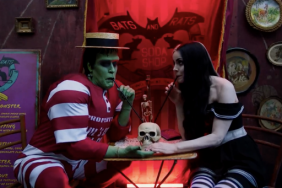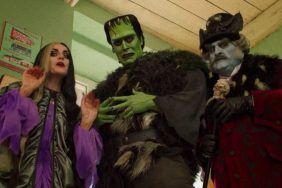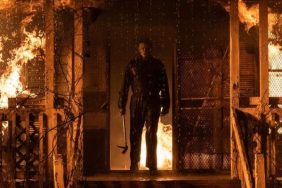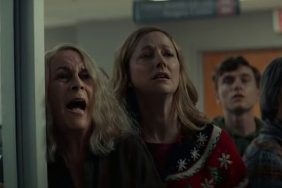Welcome back to the Remake Rumble, where we pit film against film in a no holds barred cage match for supremacy. Remakes are all the rage in Hollywood, and have actually been a mainstay in the industry since before the dawn of sound, and you know what? They’re not all bad. Every two weeks here at CraveOnline we take an original film and watch it back-to-back with the original to determine once and for all which is better, or at least if they’re both good enough to stand on their own. For this edition, since Halloween is right around the corner, we’re going to take a look at Halloween II… and Halloween II.
Why not Halloween and Halloween? Gee, I dunno, don’t you think that argument has been done to death? Rob Zombie’s 2007 remake of John Carpenter’s classic 1978 original did pretty well at the box office, but even though it has its fans – somewhere – there are very few who consider it worthy of standing next to the movie that defined the slasher genre. Carpenter’s Halloween remains a classy, fluid horror movie with a razor sharp plotline and strong performances across the board, while Zombie’s version dwelled on unnecessary backstory that diminished the villain’s effectiveness. It’s not awful, but it’s comparatively crass and self-indulgent.
Halloween II, however, is another story. The 1981 follow-up to Halloween wasn’t all that good to begin with, giving Zombie’s 2009 version a fair chance to compete. Which version is better? Let’s take a look right now…
WHAT ARE THEY ABOUT?

Both films kick off immediately after the events of the previous Halloween. Michael Myers escaped from a mental institution to wreak bloody havoc on the town of Haddonfield, Illinois, leaving mostly corpses in his wake. At the end of both versions of Halloween, Michael Myers appeared defeated, with the only prominent characters to survive the massacre being heroine Laurie Strode (Jamie Lee Curtis in the original, Scout Taylor-Compton in the remake) and Dr. Loomis (Donald Pleasance, later Malcolm McDowell).
From this point on the two Halloween II’s diverge considerably, but both films feature a bloody rampage at the hospital where Laurie is treated for her many wounds, and delve into dream sequences that our heroine to Myers. In the original Halloween II we learn for the first time that Laurie is Myer’s baby sister, who was raised in foster care and completely unaware of her relation to the famous killer. In Rob Zombie’s remake, the audience was aware of the connection since the previous film, but Laurie discovers the information for the first time over the course of the film. In both movies, Laurie struggles to cope with the horrifying revelation while simultaneously tangling with her older brother in the big climax.
WHAT’S DIFFERENT?

In short? A lot. In long, it’ll take a while.
The 1981 version of Halloween II, directed by Rick Rosenthal (who returned to the series for its last canonical entry, Halloween Resurrection), mimics the original film in many ways. It takes place over the course of a single night – the same night as the previous Halloween – and regularly cuts between the skeleton crew of Haddonfield’s hospital as they are picked off one-by-one at the hands of Myers, who is on a mission to murder his sister, and the efforts of Dr. Loomis to take the killer down once and for all.
In the 2009 version of Halloween II, the events of the original Halloween II are largely relegated to the opening of the film, where Laurie tries to flee the wrath of Michael Myers at a similar hospital. The truncated plotline gives the sequence a greater sense of immediacy, and creepy imagery like the part where Laurie falls into a vat of corpses creates a dreamlike atmosphere. Which is fitting, since it turns out to be a dream.
The rest of Zombie’s Halloween II takes place two years later, in the days leading up to October 31st. Laurie and Annie (played by Danielle Harris), who surprisingly survived the first film, are both dealing with the post-traumatic stress they endured after the first attack of Michael Myers. Laurie is still in therapy, and struggles with bouts of rage, depression and paranoia. Unlike the original Halloween franchise, Dr. Loomis has actually moved on from the Michael Myers fiasco, having reinvented himself as a quasi-celebrity thanks to his new book about his former patient and his famous massacre. He deals with the trauma by distancing himself so thoroughly that he has forgotten the actual impact of Myers’ crimes, and is repeatedly humiliated by the press and the families of Myers’ victims over the course of the film.
In both films Myers roams free because he is assumed dead, and partakes in a few murders before he actually locates Laurie at the end of the story. Like Zombie’s first Halloween, this movie offers a closer look at his mindset, frequently showing dream sequences featuring his younger self, his mother (the director’s wife, Sheri Moon Zombie) and a white horse, which an opening title card informs us represents an emotional outburst waiting to happen. Like the original Halloween II, Laurie is clued in to her connection with Michael Myers through some creepy dreams, but the extended chronology of the 2009 movie gives her the opportunity to suffer as a result of prolonged psychological duress.
Zombie’s Halloween II also picks up some threads from the other movies in the original franchise, with a genuine psychic link between Myers and his victim of choice. Laurie and Michael begin to share each other’s visions, linking psychotic behavior to nature, rather than nurture. In fact, some of Michael’s early murders are completely unjustified beyond Laurie’s tangential involvement. She’s creeped out by a local strip club proprietor (Lost’s Daniel Roebuck) appearing in public as Frankenstein, and sure enough that man turns out to be Michael’s next victim.
At the end of the first Halloween II, Laurie escapes and Loomis appears to have died in a final confrontation with Myers. At the end of the (obviously loose) remake, Laurie is institutionalized after Myers dies in a hail of gunfire, having tried to murder Loomis herself. The visions persist, implying future sequels in which she will become the killer instead, although that’s just speculation at this point.
WHICH VERSION IS BETTER?

Zombie’s 2009 version of Halloween II dwarfs the original in ambition and scares, but that has a lot to do with how limp the old Halloween II was in the first place.
Rosenthal’s Halloween II doesn’t have much going on upstairs, which we imagine was in an attempt to capture the narrative simplicity of the original. But what Rosenthal, and in all fairness John Carpenter (who co-wrote the screenplay), failed to do was create a cast of likable, involving characters. The straightforward death toll of the first Halloween was effective because of Carpenter’s masterful pacing – something Rosenthal can’t boast here – and a group of talented, mostly young actors we didn’t actually want to see murdered. The 1981 Halloween II introduces a new cast of protagonists at the hospital, but with the exception of The Last Starfighter’s Lance Guest, none of them make much of an impression (and Guest has very little to do anyway). We’ll make one exception for character actor Leo Rossi, who makes a distinct impression as a sex-crazed and yet somehow boring douchebag. There’s a scene between most of the hospital staff, filmed in a single master shot, whose pacing is entirely dependent on the charisma of the actors, and Rossi in particular seems to screw up the scene with awkward pauses between dialogue readings, which looks for all the world like he kinda just missed his cues.
The only characters we actually like in the original Halloween II are Loomis, who reprises his role from the original film so well that he goes through almost the exact same plot points (nobody believes him, but they should have, how frustrating, etc.), and Laurie Strode, who by necessity of the plot spends most of the film in bed. Not much rooting interest there. In contrast, Rob Zombie’s brief retread of the hospital sequence at the beginning of his remake offers a smaller but thoroughly likable cast of characters, including The Help’s Octavia Spencer and Office Space’s Richard Riehle, both of whom immediately elicit audience sympathy before they are murdered in straightforward but brutally realized death scenes.
Beyond another simplistic series of kills, Rosenthal’s Halloween II has only one other goal, and that’s to establish that Laurie is Michael Myers’ sister. But the plot point feels tacked on, and serves no other function except to justify why Myers would go out of his way to track her down again. In this regard, Zombie had an admitted leg up on the original, since he knew their relationship would be important while he was making his first Halloween remake. He was able to build an entire sequel around that connection, and turn Laurie’s dream sequences into a major plot point that affects her emotionally on a primal level. We’ll get back to that in a minute.
Zombie’s Halloween II does a better job than both the original Halloween II and his own previous film when it comes to introducing a strong supporting cast. His version of Halloween spent so much time looking at Michael’s childhood that the cast of ill-fated teenagers weren’t even introduced until the second half, and as such felt less important than they should have been, at least for their deaths to actually mean anything. In Halloween II he spends more time with the Brackett family, Annie and her father (played by a particularly lovable Brad Dourif), so their upcoming tragedies really resonate. Laurie’s co-workers at a record store, played by Heroes star Brea Grant and the relatively unknown Angela Trimbur, are portrayed as uniquely sympathetic to Laurie’s plight, so their inevitable demise feels particularly unfortunate.
And of course Zombie milks those dream sequences for everything they’re worth, (melo-) dramatizing the hell out of every single one. They’re creepy but outlandishly blunt, which is a good way to describe the director’s cinematic oeuvre to date. But at least he recognized that the dreams were only interesting part of the original movie and chose to focus on them. The ending of the remake is bold and disturbing, and even though Zombie oversells every single plot point, the characters are so much more interesting than the original Halloween II that the film always qualifies as an upgrade.
THE FINAL VERDICT:

Neither version of Halloween II is a classic, but unlike the original, Rob Zombie’s 2009 version of the story is brimming with energy and intriguing concepts. At over two hours it overplays its hand, but it’s still worth recommending. The original Halloween II? Not so much. Like most of the original Halloween sequels it’s worth skipping altogether.
It’s pretty ironic that the remake would be the version that isn’t spinning its wheels in a poor attempt to recreate the success of an earlier film. While I can’t quite recommend watching the original Halloween followed by Zombie’s Halloween II, it would certainly make for a fascinating double feature.
Come back in two weeks for another edition of Remake Rumble here at CraveOnline! If you have any suggestions for future editions, feel free to throw them out in the comments below.







